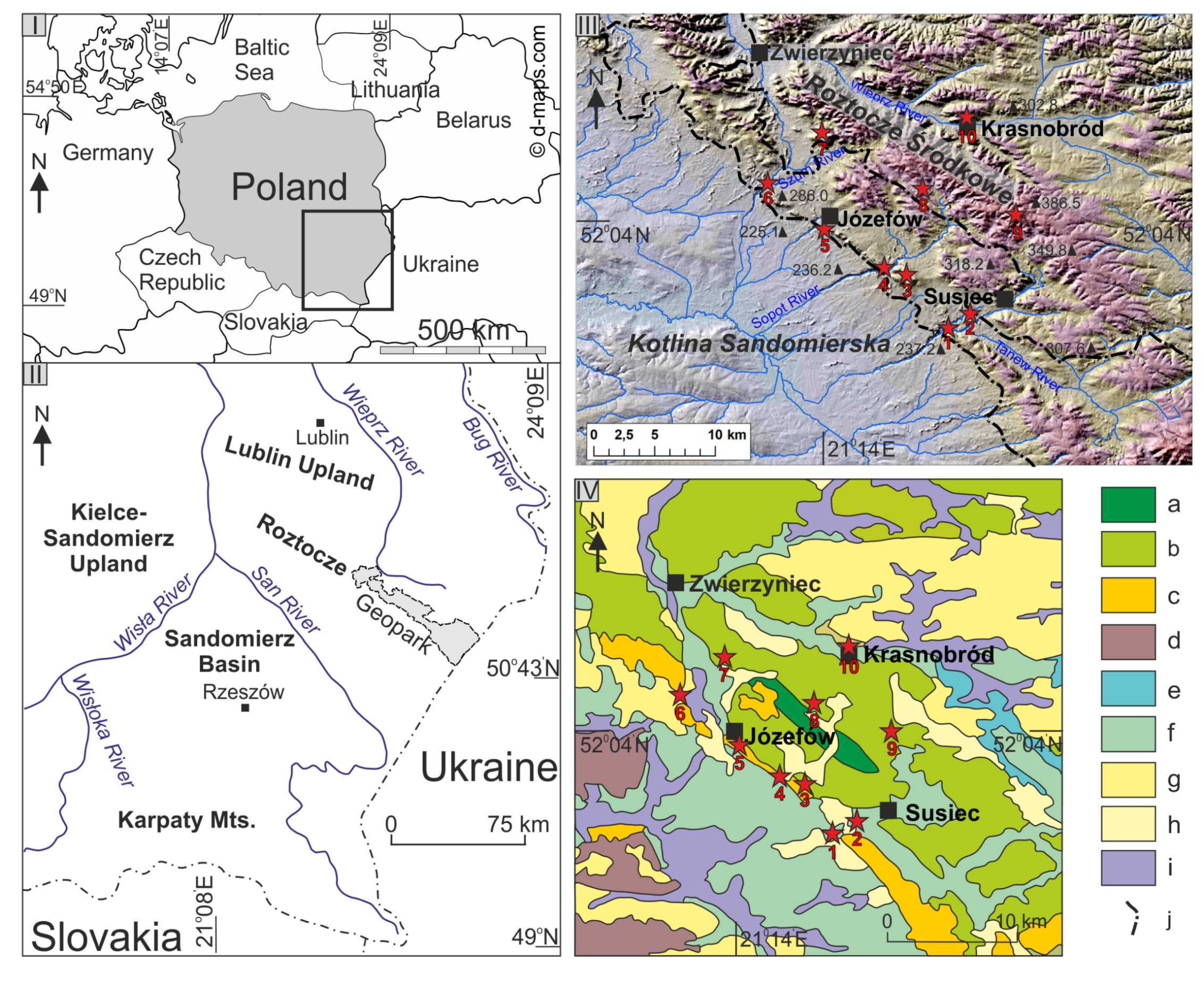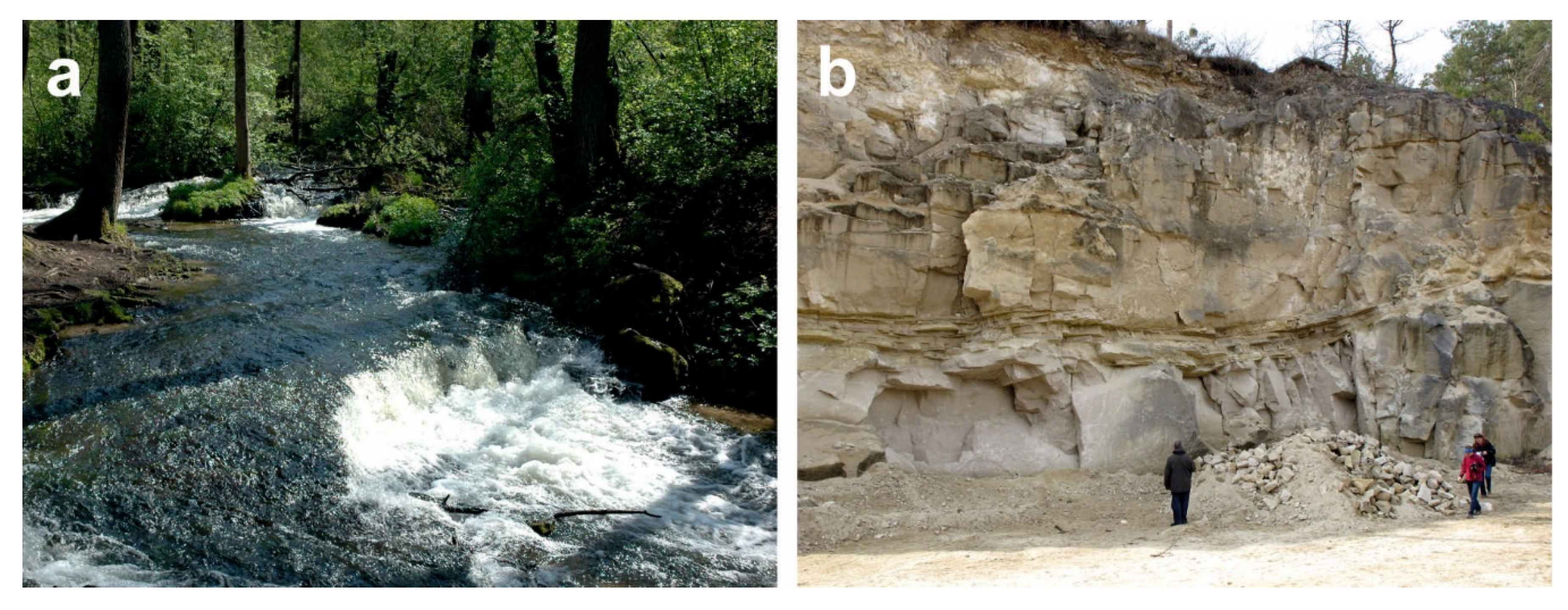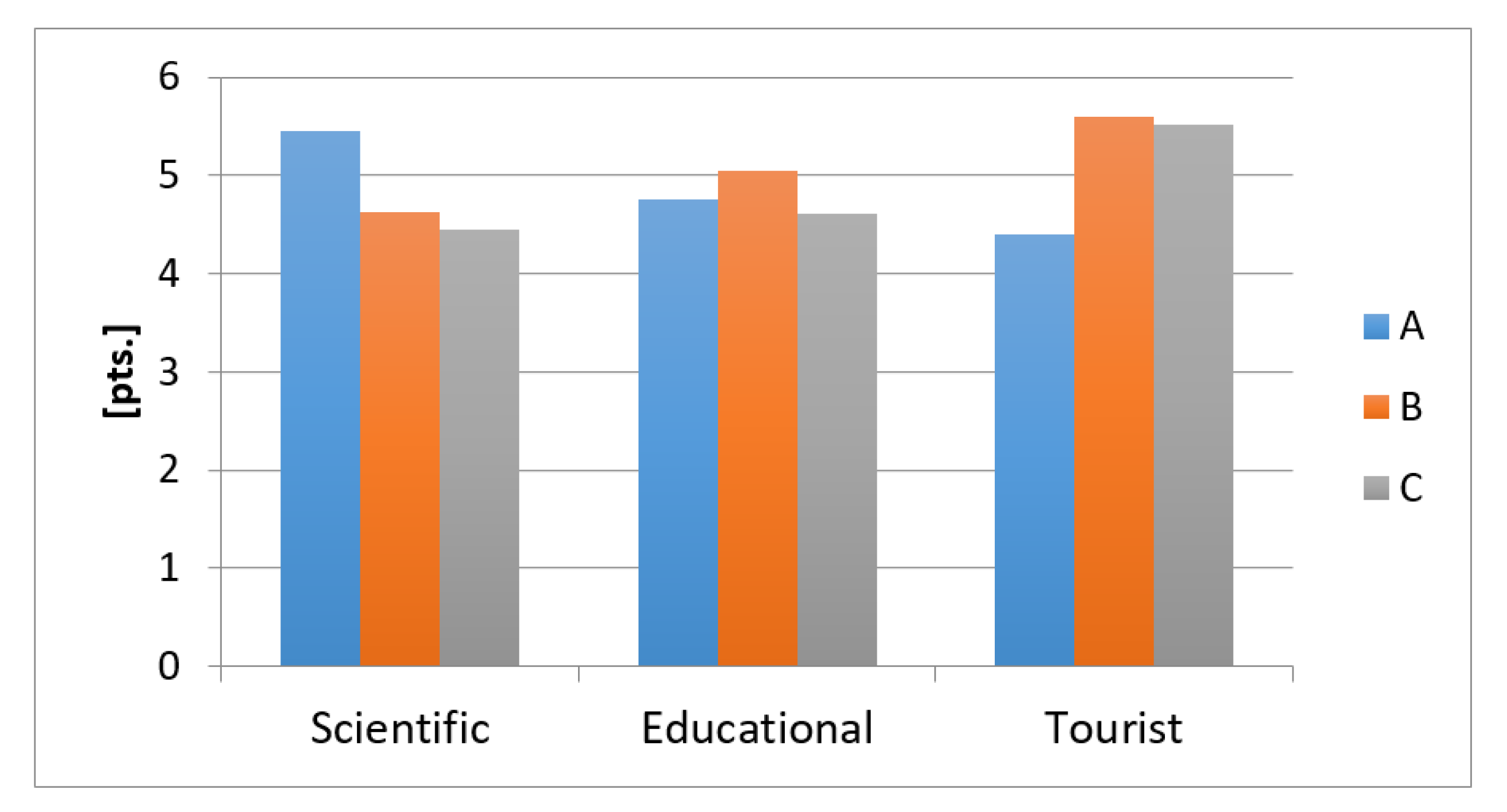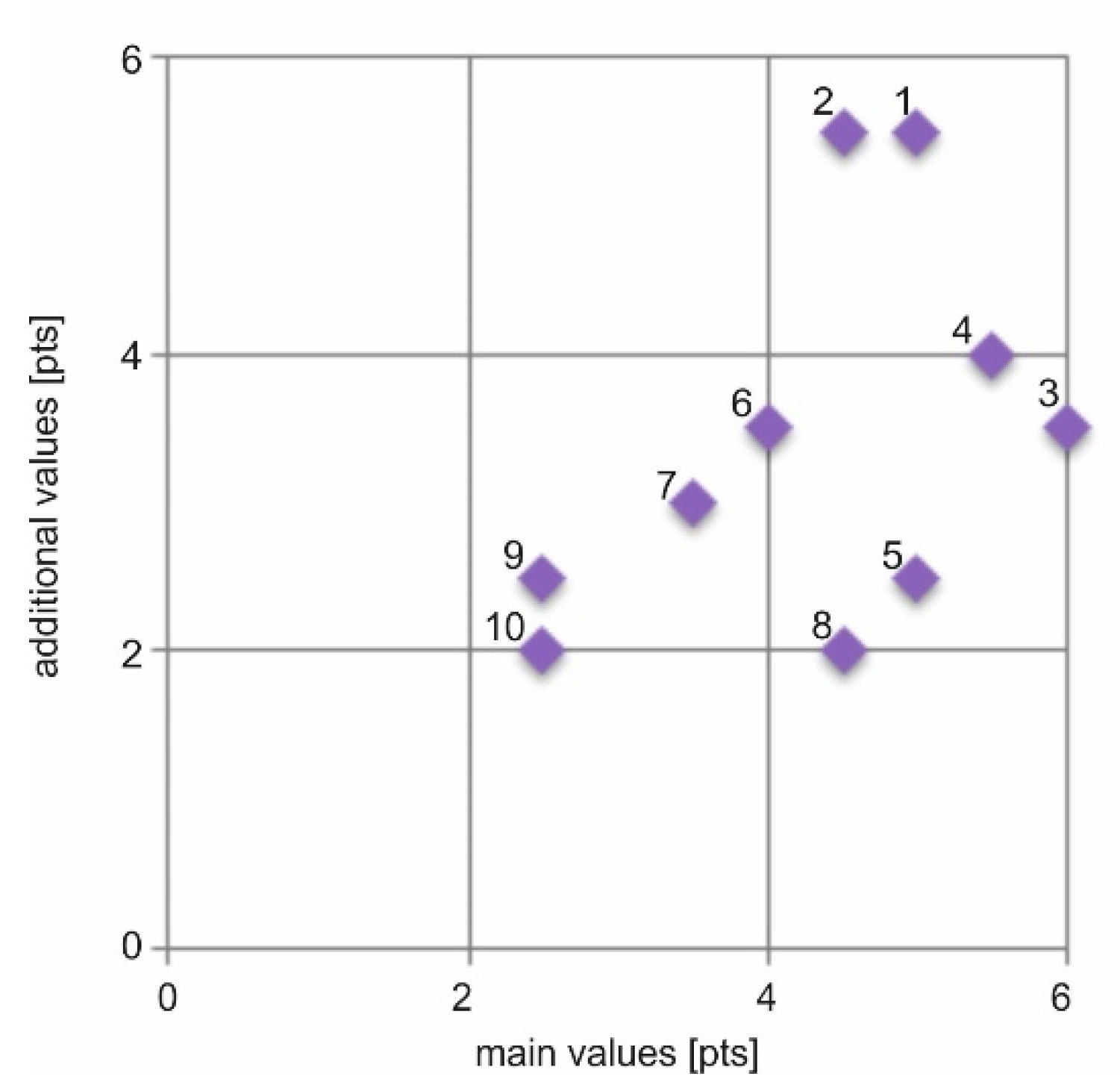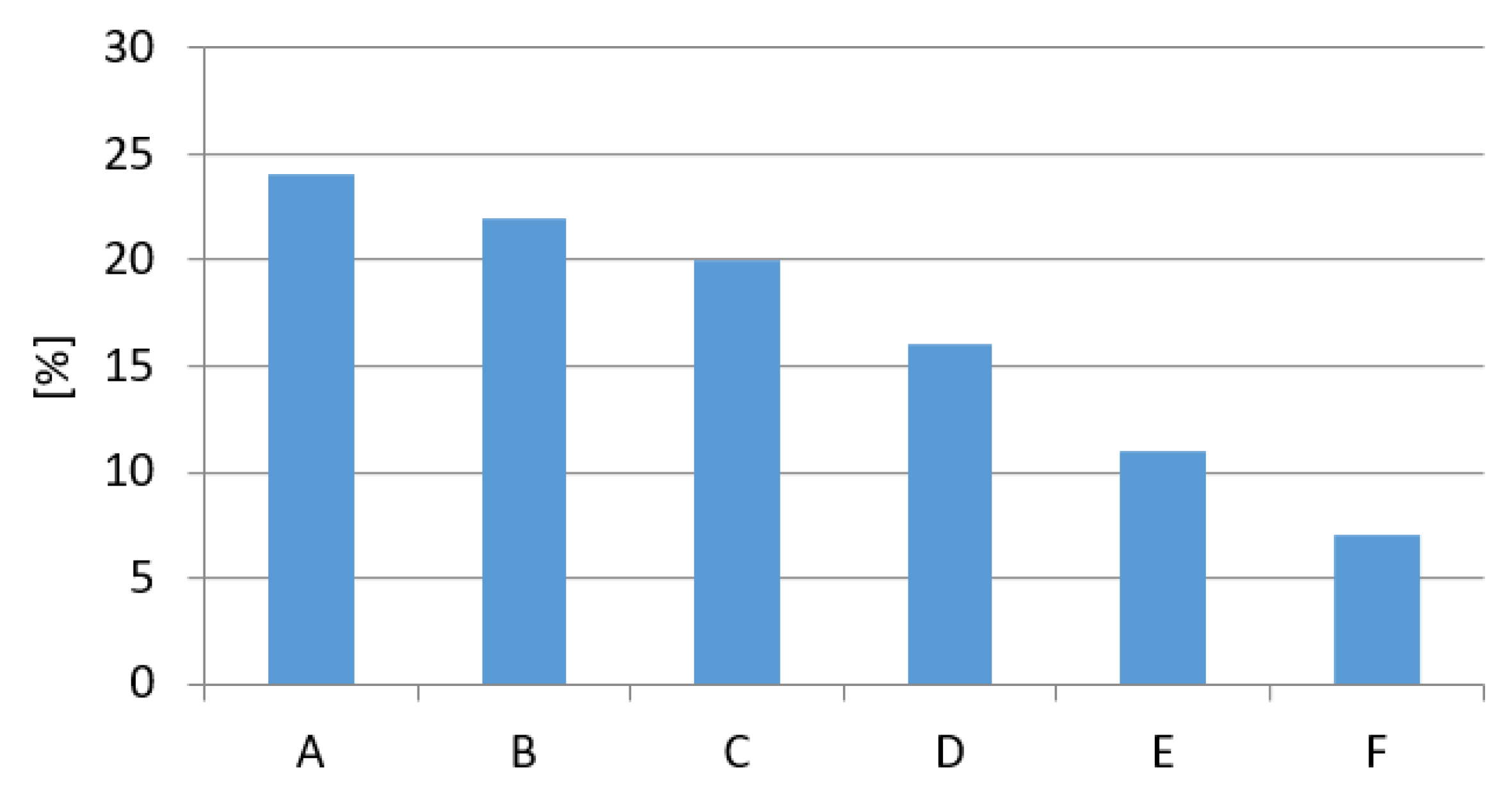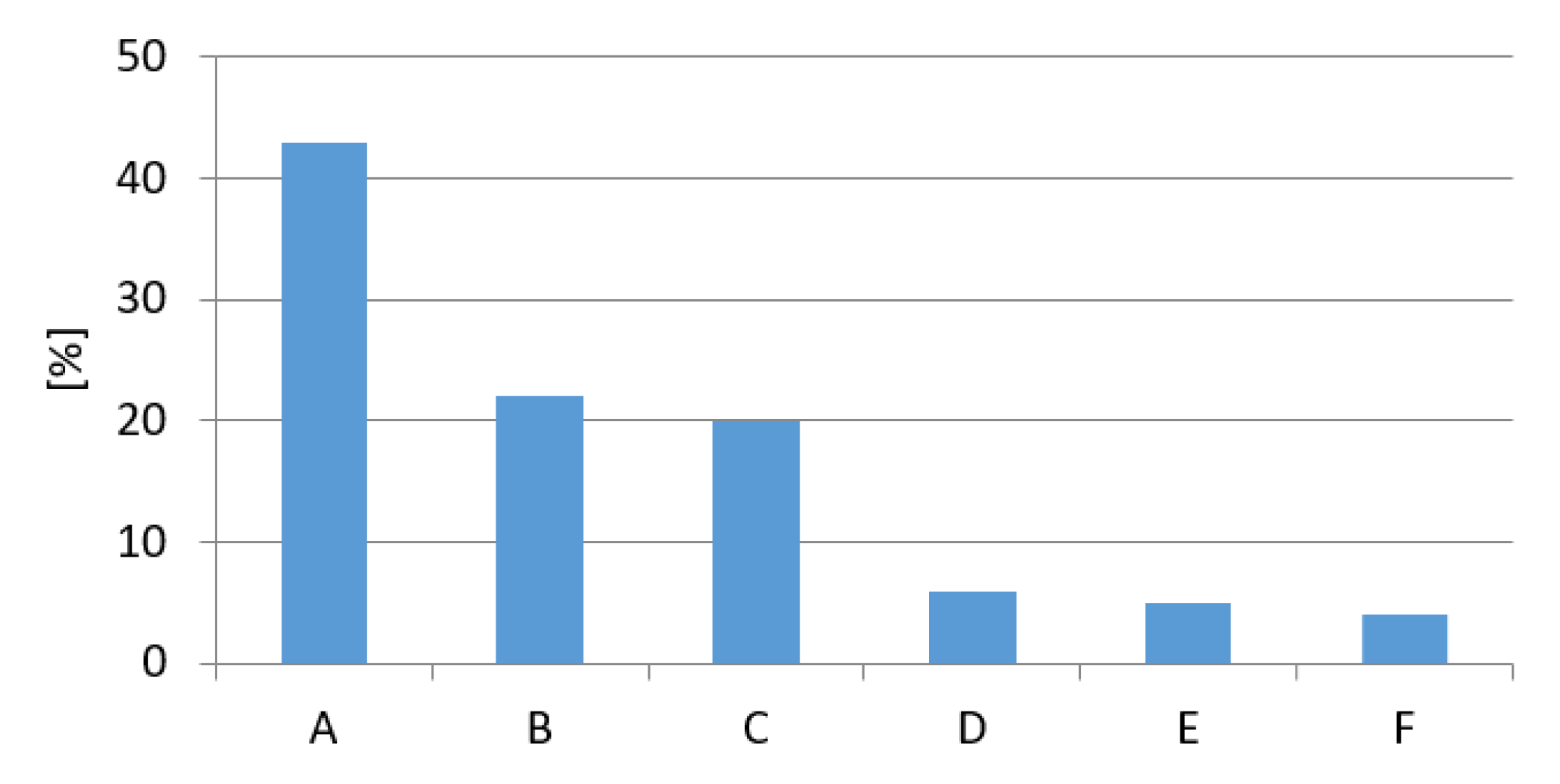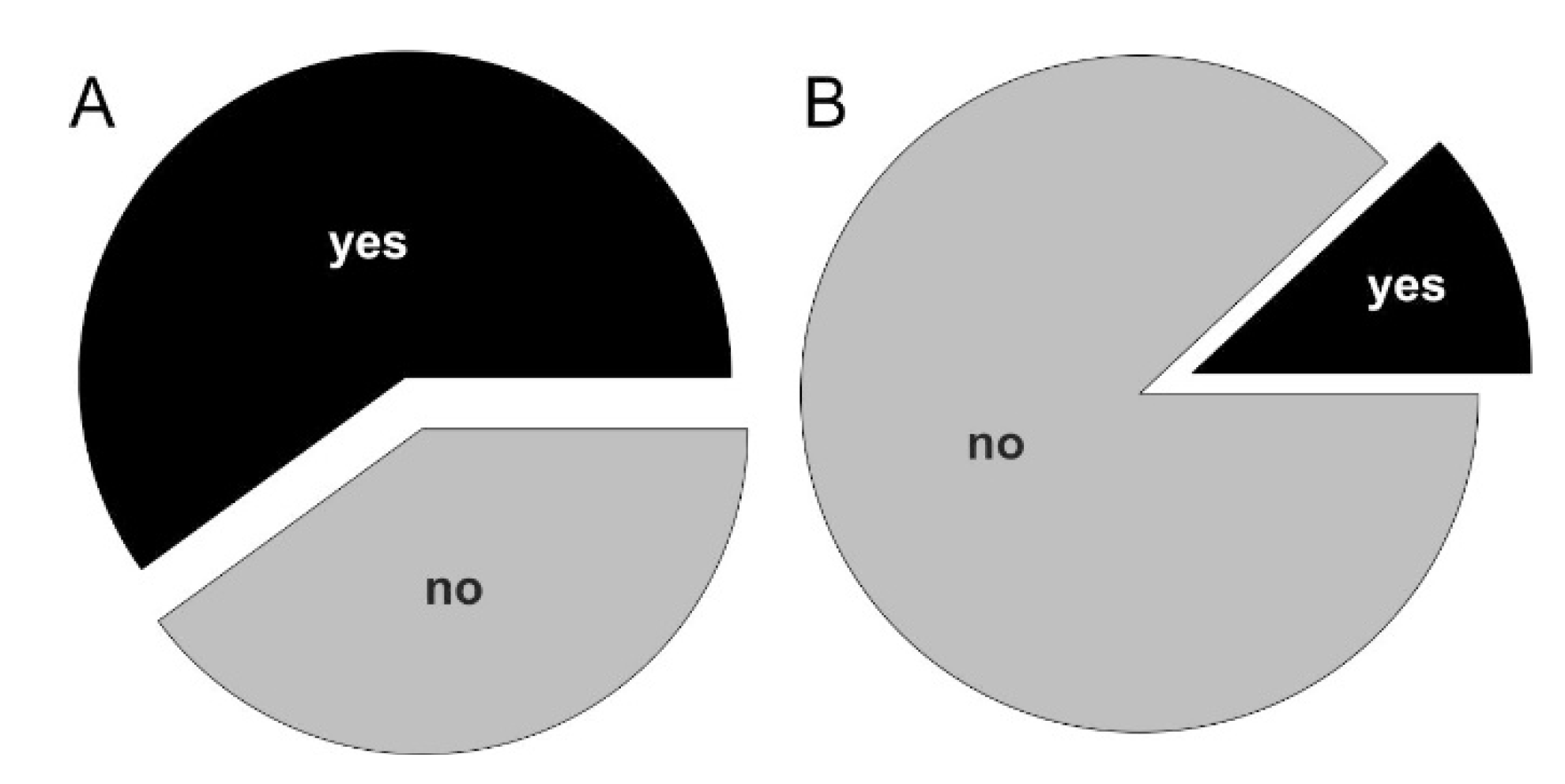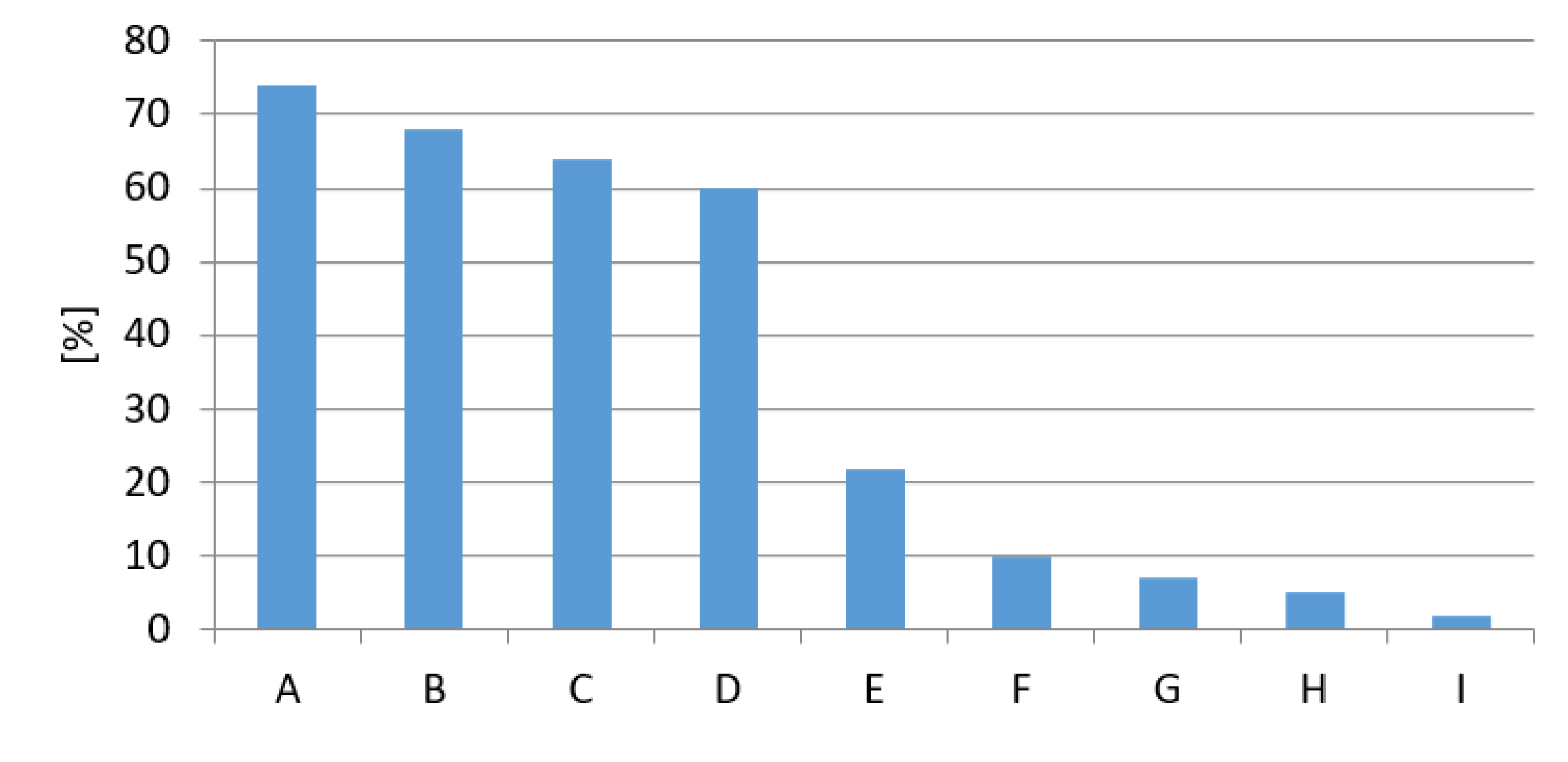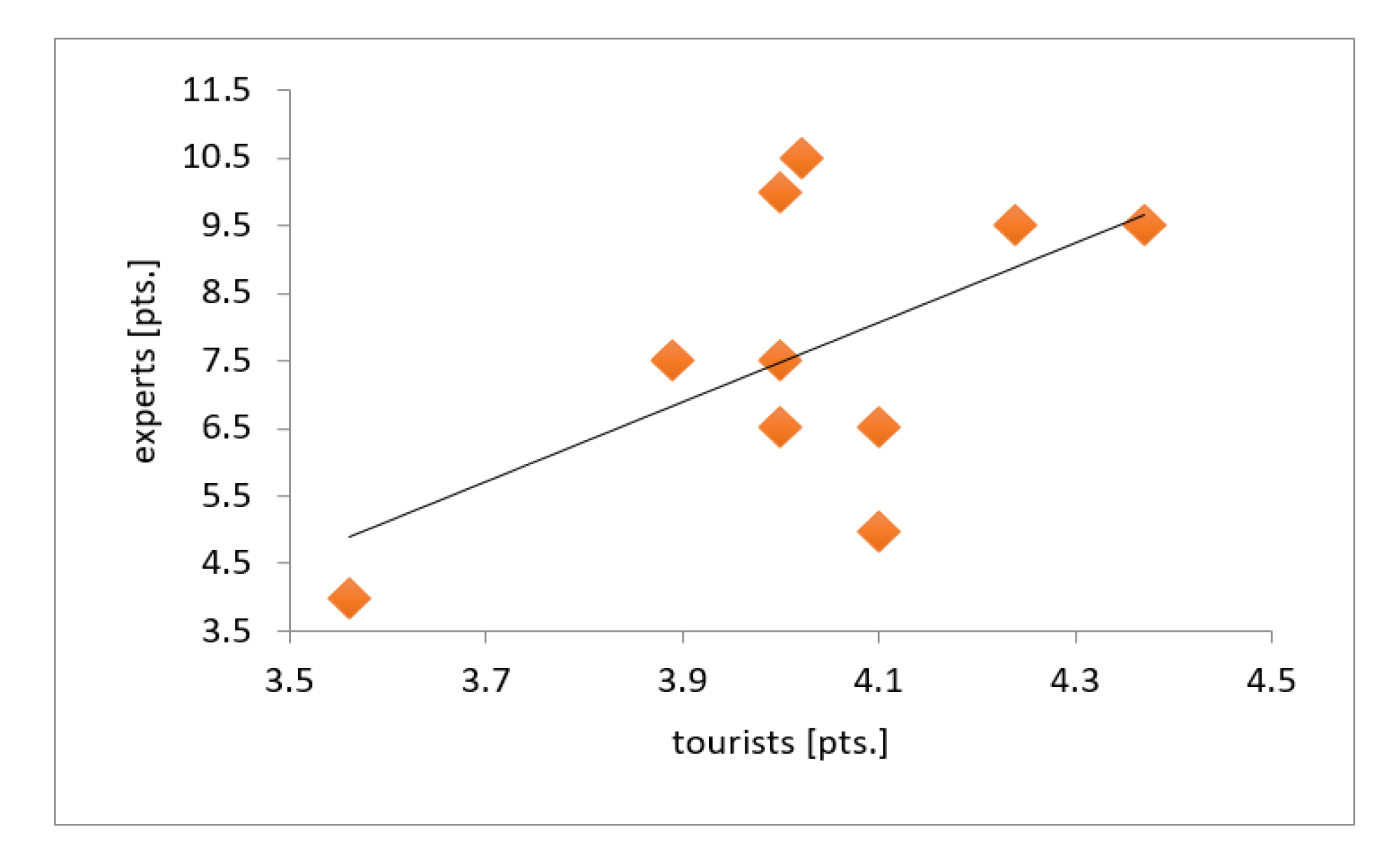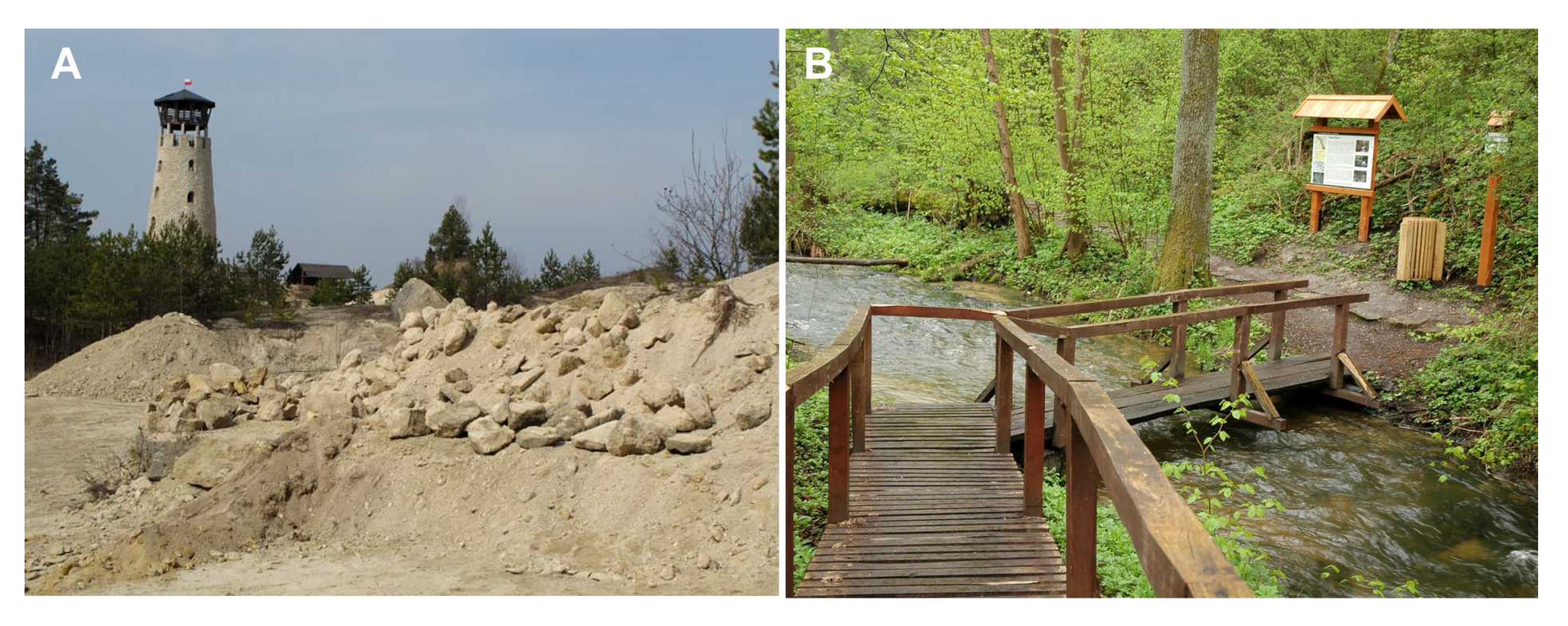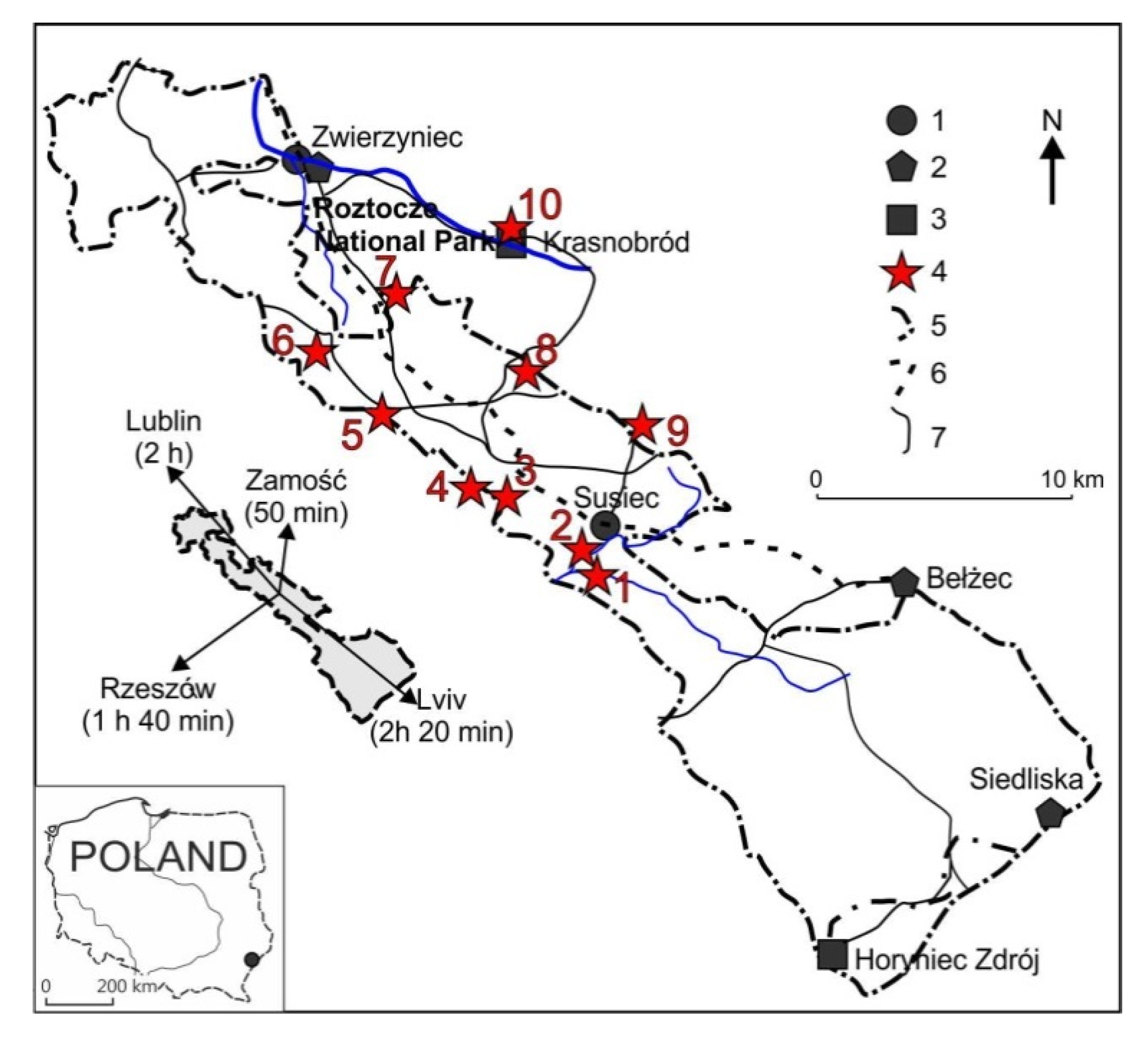1. Introduction
Geotourism is a form of on-site cognitive tourism focused on geological and geomorphological (landscape) assets [
1,
2]. It promotes visits to geosites and preservation of geodiversity [
3]. Geoparks have a special role in the development of geotourism—“
geographical areas where geological heritage sites are part of a holistic concept of protection, education, and sustainable development” [
4]. The appropriate use of geoheritage resources of a particular area and the development of the geotourist function should be preceded by a diagnosis of the current state in this respect [
5,
6,
7]. This enables the planning of the kind of measures aimed at transforming geoheritage resources into geotourist attractions. Such studies constitute an indispensable element of establishing geosites and geoparks. An assessment of geotourist assets can be carried out by means of an expert evaluation [
8,
9,
10,
11,
12] or questionnaire surveys among tourists and residents [
13,
14,
15,
16,
17]. Both methods of assessing geoheritage resources have their advantages and limitations. Questionnaire surveys seem to be particularly interesting, owing to the possibility of obtaining information directly from persons who are the actual recipients of a specific geotourist offer. Understanding the profiles, motivation and preferences of tourists is indicated as one of the most significant directions of geotourism studies [
6].
The problem of Poland’s geotourist assets attracts more and more attention in the scientific literature (e.g., References [
18,
19,
20,
21,
22,
23,
24], and many others). Three national geoparks have been established, and designs of new ones are being prepared. The scientific basis for the development of geotourism is getting better and more complete. However, there is a lack of reliable, popular science information on the geotourist resources of the particular regions, lack of promotion, and a shortage of developed tourist products [
11,
24,
25].
The primary objective of the study was to assess the geotourist resources of the Central Roztocze Region located in south-eastern Poland, for which the design of “The Stone Forest in Roztocze” Geopark was prepared [
26]. Using two assessment methods made it possible to compare the perspectives of specialists (scientists) and users (tourists) on the assets of geoheritage sites. Analyses of this kind are carried out relatively rarely. Another objective of the study was to determine whether local authorities and institutions responsible for tourism development appreciate the existence of geotourist assets in this area, as well as possibilities of regional development related to the Geopark project. Our comprehensive studies enabled the identification of the strengths and weaknesses of the region, as well as actions that should be taken to make better use of its geotourist potential.
Until now, three areas in Poland received a national geopark certificate: The Polish part of the cross-border Geopark Łuk Mużakowa (Muskau Arch Geopark) (2009), Geopark Góra Św. Anny (St. Anne’s Mountain Geopark) (2010) and Geopark Karkonosze (Karkonosze Mountains Geopark) (2010). The certificates were issued by the Minister of the Environment, but after the establishment of the geoparks above, the State lost interest in this initiative. The Muskau Bend Geopark now has the status of a global UNESCO geopark, and the “Geopark Łuku Mużakowa” association works in its territory (
http://geopark.muzakowski.pl/). The legal status of geoparks in Poland is undefined: There are no formal grounds for the functioning and management of geoparks. There is no organisation or association dedicated to the development of geotourism on the national scale. Geoparks are isolated projects that currently receive no support from the State. The geopark area partially overlaps with the national park area (Karkonosze Mountains Geopark) or nature reserve area (St. Anne’s Mountain Geopark). The protection of geoheritage assets in Poland is based on the protection of areas and objects: National parks, nature reserves, natural phenomena. In the case of a geopark, the location within a protected area with a strict conservation regime may be an obstacle to the geopark’s development because the supremacy of protecting outstanding natural assets, including geodiversity precludes the full achievement of the goals for which geoparks are established. Only the cooperation of nature protection services, local authorities and tourist organisations can intensify the development of geotourism.
The study encompassed detailed investigations of the central part of the proposed geopark in Central Roztocze, characterised by a high intensity of tourist traffic and concentration of major geotourist attractions. Tourists are attracted mainly by the region’s high diversity of landscapes. The landforms and elements of the geological structure of this meso-region become the destination for more and more tourists who begin to appreciate its geotourist assets. One can also observe an improvement in tourism infrastructure, which increases the accessibility of assets not only along general tourist trails, but also geotourist trails [
27,
28]. There are many indications that geotourism has a high potential for development but, for the time being, this potential is not fully used.
4. Discussion
The questionnaire survey results indicate that a portion of tourists (less than 30%) visiting Central Roztocze can be regarded as more or less conscious geotourists. This is confirmed by their correct answers to questions concerning terms, such as geotourism, geotourist attractions, geotourist assessment of regions. At the same time, the assessment of the value of 10 selected geosites, carried out based on the survey results, is consistent with the results of geotourist assessment results—Polish Central Register of Geosites and the assessment developed by the authors. Particularly in the latter case, a large similarity of the assessments occurred, the correlation coefficient is 0.57 (
Figure 10). Of course, one can hardly assume that the respondents’ assessment was determined by the scientific value of the sites. However, the high synthetic assessment of their tourist value indicates that abiotic nature sites arouse the interest of visitors and can be the basis for the development of geotourism. The favourable perception of geoheritage sites by tourists and residents is of key importance from the perspective of spatial management and preservation of abiotic nature assets [
17].
Questionnaire surveys also indicate that there is a group of tourists who do not regard geoheritage assets as important and interesting. Familiarity with the assessed sites plays a very significant role in this respect. A low rating of geosites very often results from the lack of information about them: The correlation coefficient between the assessment results and the respondents’ lack of knowledge about geosites is 0.62. The underground quarry in Senderki is an example of such a site. One can suppose that the situation was similar in the case of the low score of geotourist assets of regions, such as the Kaczawskie Mountains or the Suwałki Region which are actually unique on a national scale in terms of geological structure (remnants of volcanic phenomena and forms) and geomorphology (young glacial landscape). The lack of knowledge about the studied geosites was indicated by 16 to 69% (average of 38%) of the respondents. It should be stressed, however, that the Kaczawskie Mountains and the Suwałki Region are among the most valuable and generally quite frequently visited areas (with few exceptions). In the case of other geosites in Central Roztocze, the level of knowledge about them is clearly lower. Zgłobicki, Baran-Zgłobicka [
15] mentioned the significant variation of familiarity with valuable geotourist sites in the area of the potential Małopolska Vistula Gap Geopark.
A high degree of consistency between assessments occurs in the case of the following geosites—Nad Tanwią nature reserve, Waterfall on the Jeleń river, Sopot river gap valley in the Czartowe Pole nature reserve (
Table 10). This applies both to sites of undoubtedly high scientific and tourist value (Nad Tanwią nature reserve, Sopot river gap valley in the Czartowe Pole nature reserve) and those of lower value. A moderate degree of consistency occurs for the Wapielnia Hill and the Quarry in Józefów. In the case of some sites, however, quite a considerable variation of assessments was found, namely—Underground quarry in Senderki, quarry in Nowiny, “Piekiełko” rock forms, Quarry in Krasnobród. These differences result primarily from the tourists’ poor familiarity with these sites despite their high scientific value.
The gap valleys of the rivers in Central Roztocze are definitely popular and frequented by tourists. They are among the best rated geomorphological sites in the Lublin Region [
15]. They arouse the interest among tourists in other regions of the world as well [
29,
38].
One of the reasons behind the high rating given by tourists to such geosites is their unquestionable visual (landscape) value. The significance of landscape beauty in the perception, and consequently, assessment of natural components and entire landscapes are indicated by the results of previous studies [
17,
39]. There is no doubt that geotourism can also develop based on the assets of the cultural landscape [
40]. In this respect, a special role can be played by a large number of quarries in Central Roztocze [
28,
41,
42]. Some of them are located close to important tourist localities, which is a significant advantage. In addition, their tourist and geotourist value are enhanced by the existence of observation towers [
43]. The quarries also make it possible to actively learn about geological assets by observing and collecting rocks and fossils. It is particularly important from the perspective of the educational function of geosites, particularly with respect to children and youth [
24]. Thus, it seems that the first promotional measures and development of geotourist products in Central Roztocze should be based on greater use of the selected quarries.
Very few people have heard about the proposed geopark, which is not surprising, given that this term is mostly used in the scientific literature. Studies conducted in Kielce (central Poland) at the turn of the 21st century show that even geography students were not familiar with this concept: Only 40% of them were able to provide a correct definition [
14]. At the same time, actions aimed at establishing the geopark seem to be the only possible direction of geotourism development in this area. Therefore, as other authors indicate, it is necessary to conduct in-depth studies on the motivation of tourists visiting abiotic nature sites in Central Roztocze [
16].
Tourists indicated certain deficiencies in the geotourism development of Central Roztocze. The most frequently mentioned issues include the lack or inadequate marking of tourist trails, the lack of or insufficiently detailed interpretation panels, poor condition of geotourist sites, lack of information and maps with marked geotourist sites (
Table 11). According to tourists, the most important elements are absent, namely the marking of trails and interpretation panels. The only geotourist product developed so far is the Geotourist Trail of Central Roztocze [
33], but, since the map of the trail is no longer available for purchase, its impact is limited. Seven among the 10 geosites under study are located on this trail and are “equipped” with geotourist interpretation panels (
Figure 11). It seems, however, that these boards need some modification because their current content is sometimes too scientific.
The peripheral location of the studied area at the Polish-Ukrainian border and in relation to larger cities, is a challenge to the further development of tourism here. There is a lack of good roads to arrive in the area although their condition is improving (
Figure 12).
The way of presenting scientific knowledge to tourists is a key challenge to the development of geotourism [
44,
45]. Studies show that the tourists’ knowledge about abiotic nature is distinctly more limited than in the case of the fauna and flora [
46]. The same also applies to students of natural science study programmes [
14,
25]. It is necessary to prepare popular science products presenting geoheritage information in an accessible way. Even in the case of sites of outstanding value, such as the Giant’s Causeway, tourists indicate the need for the improvement of interpretation panels with regard to format, size and content [
46]. Questionnaire surveys conducted in the vicinity of the Iguazu Falls National Park show that about 70% of tourists do not read the information presented on the interpretation panels [
43]. This may result from the inadequate location of the panels, the poor finishing of the panels, or long-winded, hermetic language. On the other hand, individuals who
have read the information presented on the panels give them a favourable rating. Well-prepared interpretation panels can, thus, be an important means for tourists to acquire knowledge about the geological and geomorphological assets of a given region.
In modern times, the Internet is the most common and the fastest source of information. The Polish Central Register of Geosites is the database providing information about the geological assets. However, this information is often incomplete, and the descriptions are not easily digestible for ordinary tourists. Efforts should be made to create and launch a geoportal—a database of natural assets (components of biotic and abiotic nature) at the regional level. It could be complemented by a mobile application providing the basic information on the region’s natural environment, geosites and geotourist paths. However, Rozenkiewicz et al. [
47] indicate that still in Central Europe “
information on geotourism resources available online is rather dispersed”.
All actions aimed at establishing geoparks and developing geotourism should be based on the involvement of local communities in the process [
4]. Therefore, it is necessary to persuade residents that using landscape and preserving geoheritage assets for geotourism purposes generates social and economic benefits [
48]. The influence of geoparks on local economy and regional development can occur by means of [
49]: (i) Production of geoproducts (souvenirs, handicrafts, geofood), (ii) involving local business in geotourism marketing, (iii) development of recreational and sports activities related to geomorphology and geology (geokayaking, geohiking, climbing). In the case of Central Roztocze, Brzezińska-Wójcik [
27] mentions several decorative geoproducts, geofood, and themed towns associated with masonry that can help in the education, interpretation and promotion of geoheritage.
Based on examples from Iceland, Australia and Malaysia, Dowling [
48] indicates that the immediate benefits that local communities can derive from the development of sustainable geotourism include increased opportunities for employment and generation of additional revenue. The bottom-up strategy is the most efficient for the promotion and development of geotourism, as well as actions aimed at establishing geoparks. This is exemplified by the activities of the Local Action Group
Land of Extinct Volcanoes, encompassing 14 districts in SW Poland, aimed at promoting and educating the public about geoheritage assets [
50]. Unfortunately, the attempts to establish such an organisation in Central Roztocze have not been successful so far.
The appropriate positioning of the preservation and tourist use of abiotic nature assets in the spatial planning and economic development system is of fundamental importance to the establishment of the Geopark and the development of geotourism, including its new forms. At the central planning level, in the 2030 National Spatial Development Concept [
51], geoparks are merely mentioned in the spatial development vision as elements (nodes) of Poland’s ecological network. In the draft National Raw Material Strategy [
52], the establishment of geoparks is an action within the preservation of geodiversity.
At the regional level, in the Development Strategy for Lubelskie Province for the years 2014–2020 [
53], and in the Spatial Development Plan for Lubelskie Province [
54], the Central Roztocze meso-region is in a separate area of strategic intervention—area of the economic use of natural and cultural assets—in “
the Roztocze and Solska Forest functional area and areas with identified health resort assets.” The Strategy [
53] defines the operational objective that encompasses the rational and effective use of natural environment resources for economic and recreational needs, while preserving and conserving the natural environment assets. The Plan [
54] also sets out the framework for the conservation of abiotic nature, within which it proposes the establishment of geoparks and placing the most valuable assets of abiotic nature under the protection of the law. It indicates the proposed geopark “Stone Forest in Roztocze” as an area of geological heritage protection that should be used for the extensive promotion of geological sciences and propagation of the educational and tourist functions of geosites, while ensuring their effective protection. According to the Plan, nature and sightseeing tourism using the assets of abiotic nature requires special developmental stimuli.
The Programme for Tourism Development in Lubelskie Province until 2020 with a perspective until 2030 [
55] mentions the problem of geotourism only when indicating the need for tailoring specialised products to specific audiences as part of nature tourism. The lack of a broader approach to geoparks and geotourism in a sectoral problem at the regional level does not create a climate favourable to their development. What is more, the Polish legal system does not provide any regulations concerning the formal establishment, rules of functioning and management of geoparks.
The situation is not much better at the local level. In the development strategies of local governments of six districts within which the sites included in the questionnaire surveys are located, only the abiotic resources and a very general framework of tourism development are presented to a varying extent (
Table 11). In some cases, specific measures are indicated, but they do not apply directly to geotourism either. Issues related to tourism are covered most broadly in the Development Strategy of the Town and District of Krasnobród. Districts located in the functional area of Roztocze and Solska Forest [
56] established a group called “Active Roztocze”, for which a strategic territorial-functional plan was prepared up to the year 2023. The Geopark is indicated as a significant element of the integrated tourist product.
The area of the planned geopark has valuable abiotic nature assets but, at the same time, there are several unfavourable internal factors that pose a serious challenge to the development of geotourism (
Table 12). Making the most of the existing potential can be facilitated or impeded by external determinants. Developmental stimuli arising from the formal and legal regulation of the functioning of geoparks, along with the institutional and financial support from central and regional governments, are particularly important.
Spatial planning does not offer any practical solutions with regard to the tourist use of geoparks because the planning of spatial development is merely a segment of spatial planning. The problems of the location and rules of the functioning of tourist infrastructure are discussed in planning documents on a par with problems related to housing and economy, social and technical infrastructure, environmental protection, etc. These problems as a whole are regulated by the Act on Spatial Planning and Development [
57]. At the same time, the formal links between strategic and spatial planning are quite loose at the local level. It should be stressed that the geoparks are not discussed in the current Act on Nature Conservation [
58]. Since they do not exist in the legal system, including the laws on nature conservation, it is very difficult to take the initiative to establish and manage them. The lack of a formal framework makes it impossible to obtain organizational and financial support for the process of geopark creation. They are not included in the spatial planning system either. Only the proposed National Raw Materials Policy mentions the protection of geodiversity through the establishment of geoparks, among other measures. Geoparks were mentioned only in the bill on the Polish Geological Agency with the attached Council dealing with the certification of geoparks and responsible for information, education and promotion. At the same time, there are no regulations imposing an obligation to prepare master plans for geoparks.
Geotourism, as a form of the sustainable development of rural areas and using land resources of high natural value, requires the involvement of local small business, as well as appropriate instruments and management [
48]. Local governments in Poland are not actively initiating the creation of geoparks or supporting the actions of local communities [
59]. The lack of systemic regulation of the formal status and management rules of geoparks is currently the biggest challenge. The need to protect geoheritage, on the one hand, and appropriate tourist development, on the other, forces the conflict-free coexistence of various functions in the use of space. The proper functioning of geoparks, stimulating local development, requires appropriate provisions in strategy and planning documents at various levels of government. Particularly significant is the local level where, due to the autonomy of districts with regard to planning, it is necessary to introduce detailed provisions into planning documents. In the context of tourism (including geotourism) planning and management, it is necessary to develop strategies of tourism development. In the case of geoparks, it is indispensable to prepare professional master plans [
60] that are the basis for the operation of managing bodies, typically established by way of agreements of local governments, and enable the practical implementation of the idea of a geopark as part of business [
61]. A geopark should be managed by a clearly defined structure, operating in accordance with the provisions of the law that would also enable the preservation of the assets and sustainable development. The body managing a geopark could play an active role in the economic development of a region. It should cooperate with local businesses in order to promote and support the creation of new products associated with geological heritage [
60,
61,
62,
63,
64,
65].
